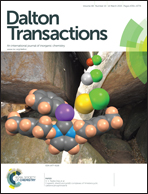Investigation of the structure and ionic conductivity of intercalated kaolinites with potassium acetate in hydrous and anhydrous phases†
Abstract
The intercalated kaolinite with potassium acetate (K-KAc), with ca. 91.9% intercalation ratio, was prepared. Thermogravimetric and variable-temperature X-ray powder diffraction analyses disclosed that a small amount of water is easily absorbed into the interlayer space of the K-KAc. The previously reported phase with the 14.2 Å interlayer distance is actually the hydrous K-KAc, which has an approximate formula of Al2Si2O5(OH)4·0.5KAc·0.25H2O. The crystal structures of hydrous and anhydrous phases of K-KAc were simulated in the density functional theory framework, demonstrating that the interactions between the K+ and acetate ions and the inner surface of kaolinite are significantly strengthened in the anhydrous phase with regard to the hydrous phase. The ionic conductivity of K-KAc indicated that the mobility of the interlayer ions is strongly improved by thermal activation and the conductivity increased by four orders of magnitude from 363 to 423 K.


 Please wait while we load your content...
Please wait while we load your content...